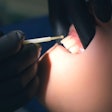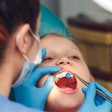
Brittle bones, kidney stones, thyroid disease -- even an asthmatic's wheeze: fluoride gets blamed for a lot of health problems. Noting such concerns, oral health agencies in several countries are recommending that fluoride supplements be given only to children at highest risk of caries, or to no one at all. Now the ADA is mulling such a similar shift in its own guidelines.
The chair of a working group for the association concluded in an article for the November issue of the Journal of the American Dental Association that the current guidelines, issued in 1994, should be "re-examined" (JADA, November 2008, Vol. 139:11, pp. 1457-1468).
Currently, the ADA and the American Academy of Pediatric Dentistry (AAPD) recommend fluoride supplements for various age groups of children whose drinking water contains less than 0.6 ppm. By contrast, the JADA review notes, the Canadian Dental Association recommends supplements only for children who have had a lot of caries and consume less than 0.05 to 0.07 mg of fluoride per kilogram of body weight from all sources. A European panel also recommended the supplements only for people at high risk, and an Australian group said they shouldn't be given to anyone.
Why the new restrictions?
The scientific understanding of fluoride hasn't changed much in the past 14 years, said Steven Adair, D.D.S., M.S., who serves on the ADA working group. "It's more a question of how best to use fluoride in practice and public health given that we have a better understanding of caries risk and children."
Measuring risk
In recent years, many leaders in caries research have called on practitioners to categorize their patients according to their risk of developing caries and devote proportionately more effort for prevention to those at highest risk. Several organizations, including the AAPD, have issued risk assessment tools for that purpose.
Dr. Adair, a professor at the Medical College of Georgia, couldn't comment on what the ADA panel was likely to recommend. But in his own practice, he looks at each patient's individual fluoride intake and balances that with the patient's caries risk.
"Some kids live in a home served by a well, but they go to a school with fluoridated water," he said. "Also kids swallow a portion of the toothpaste they use. So maybe we don't need to supplement every kid who lives in a nonfluoridated community."
One division among fluoride researchers is on the importance of swallowing the mineral. Until the 1980s, Dr. Adair said, researchers thought fluoride got into teeth systemically as they were being formed. Dr. Adair thinks some fluoride gets into enamel that way, but that the more important route is through topical contact as teeth demineralize and remineralize. In addition, he thinks fluoride present in the mouth inhibits enzyme activity in the bacteria that cause caries.
Swallow this
"A lot of us think of a tablet as a dehydrated fluoride mouth rinse," Dr. Adair said. "I tell patients to dissolve it and swish it around the mouth for a minute. It's not critical that it be swallowed."
Patients older than 7 years of age can use an over-the-counter rinse instead of a supplement, regardless of how much fluoride is in their water, he said. But since these rinses are not made to be swallowed, tablets are better in those who have less control over their swallowing reflex. Prescription rinses, which can be swallowed, are an alternative to tablets, in Dr. Adair's approach.
Kevin Donly, D.D.S., M.S., chair of pediatric dentistry at the University of Texas at San Antonio, sees the mineral differently. If his patients aren't getting fluoride in their water, he gives them supplements and wants them to swallow them. "It's systemically taken up into the enamel, and that's why we give supplemental fluoride," he said.
He pointed to a conclusion in the JADA review that fluoride supplements make permanent teeth more resistant to decay.
What about the risks? There's little research to show any side effects of fluoride at the levels in the current ADA/AAPD guidelines, other than fluorosis. The JADA review concluded that "the increasing prevalence of fluorosis, even in its mildest forms, in the United States should not be dismissed."
But Dr. Donly, for one, isn't concerned. He notes that the guidelines were revised in 1994 to reduce the risk of fluorosis, and he argues that it's too early to assume that change didn't take care of the problem. "I don't think we have evidence to change those guidelines," he said. "I wouldn't care if everybody had mild fluorosis because of the big effect fluoride has on caries."
We'll find out how the ADA working group resolves such discussions in a few months. The new guidelines will come out around spring of 2009, said Dan Meyers, senior vice president of science/professional affairs for the ADA.
Copyright © 2008 DrBicuspid.com



















